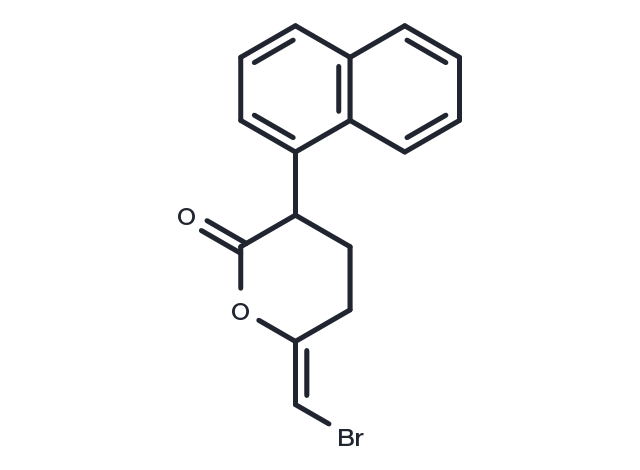Powder: -20°C for 3 years | In solvent: -80°C for 1 year


Bromoenol lactone is a suicide-based irreversible, selective, potent inhibitor of calcium-independent phospholipase A2 (iPLA2β; IC50: ~7 μM). It inhibits antigen-stimulated mast cell exocytosis without blocking Ca2+ influx.

| Pack Size | Availability | Price/USD | Quantity |
|---|---|---|---|
| 1 mL * 10 mM (in DMSO) | 5 days | $ 162.00 |
| Description | Bromoenol lactone is a suicide-based irreversible, selective, potent inhibitor of calcium-independent phospholipase A2 (iPLA2β; IC50: ~7 μM). It inhibits antigen-stimulated mast cell exocytosis without blocking Ca2+ influx. |
| Targets&IC50 | PLA2:7 μM |
| In vitro | Bromoenol lactone inhibits exocytosis when stimulated using a Ca2+ ionophore A23187, which passively transports Ca2+ down a concentration gradient and also in permeabilized mast cells where Ca2+ entry is no longer relevant. In RBL 2H3 and bone marrow-derived mast cells (BMMCs), Ca2+ entry is critical for exocytosis. Moreover, Bromoenol lactone has only a minor effect on antigen- or thapsigargin-stimulated Ca2+ signaling, both the release from internal stores and sustained elevation due to Ca2+ influx [1]. |
| Synonyms | (6E)-Bromoenol lactone |
| Molecular Weight | 317.18 |
| Formula | C16H13BrO2 |
| CAS No. | 88070-98-8 |
Powder: -20°C for 3 years | In solvent: -80°C for 1 year
You can also refer to dose conversion for different animals. More
bottom
Please see Inhibitor Handling Instructions for more frequently ask questions. Topics include: how to prepare stock solutions, how to store products, and cautions on cell-based assays & animal experiments, etc.
Bromoenol lactone 88070-98-8 Metabolism Phospholipase (6E)-Bromoenol lactone inhibitor inhibit
